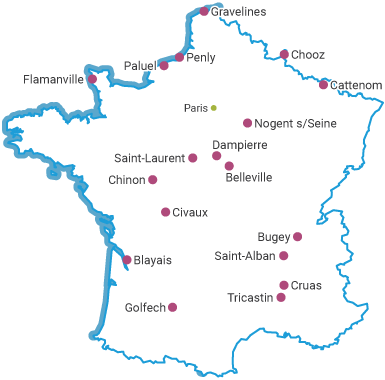Nuclear Power in France
(Updated July 2020)
- France derives about 75% of its electricity from nuclear energy, due to a long-standing policy based on energy security. Government policy is to reduce this to 50% by 2035.
- France is the world's largest net exporter of electricity due to its very low cost of generation, and gains over €3 billion per year from this.
- The country has been very active in developing nuclear technology. Reactors and especially fuel products and services have been a significant export.
- About 17% of France's electricity is from recycled nuclear fuel.

In 2017 electricity production in France was 562 TWh (gross), and of this nuclear provided 398 TWh (71%), hydro 55 TWh (10%), coal 15 TWh (3%), gas 40 TWh (7%), solar 10 TWh (2%) and wind 25 TWh (4%). After net exports of 40 TWh, total electricity consumption came to 445 TWh, about 6,500 kWh per capita on average. Installed capacity at the end of 2017 was 133 GWe1.
Over the last decade France has exported up to 70 TWh net each year. In 2017 exports were principally to Spain, Italy, the UK, Switzerland and Germany.
France has 57 nuclear reactors operated by EDF, with a total capacity of 62.3 GWe.
France's present electricity generation mix is a result of the French government deciding in 1974, just after the first oil shock, to expand rapidly the country's nuclear power capacity, using Westinghouse technology. This decision was taken in the context of France having substantial heavy engineering expertise but few known indigenous energy resources*. Nuclear energy, with the fuel cost being a relatively small part of the overall cost, made good sense in minimising imports and achieving greater energy security.
* In 2014 the US Energy Information Administration put French shale gas resources at 5094 billion m3, though recovery of this was prohibited.
As a result of the 1974 decision, France now claims a substantial level of energy independence and almost the lowest cost electricity in Europe. It also has an extremely low level of carbon dioxide emissions per capita from electricity generation, since over 90% of its electricity is nuclear or hydro.
In mid-2010 a regular energy review of France by the International Energy Agency urged the country increasingly to take a strategic role as provider of low-cost, low-carbon base-load power for the whole of Europe rather than to concentrate on the energy independence which had driven policy since 1973.
The low cost of French nuclear power generation is indicated by the national energy regulator (CRE) setting the price at which EdF’s electricity is sold to competing distributors. In 2014 the rate is €42/MWh, but CRE proposed an increase to €44 in 2015, €46 in 2016 and €48 in 2017 to allow EdF to recover costs of plant upgrades, which it put at €55 billion to extend all 58 reactor lifetimes by ten years. In November 2014 the government froze the price at €42 to mid-2015. This Arenh re-sale price has represented a long-term floor price for EdF’s power, and is nominally based on the cost of production. The industrial group Uniden said that the proposed 2015 wholesale price of €44/MWh would be €14 higher than Germany’s.
French retail prices, without major effects from feed-in tariffs for wind and solar, remain very low. In 2013 French prices for medium-size industrials were about 90% of EU-27 average, and those for medium-size households (at less than 8 c/kWh) were less than half of EU-27 average.







